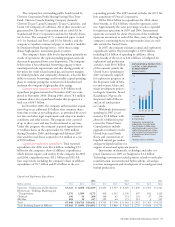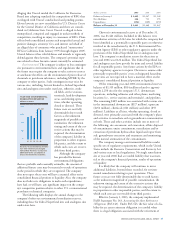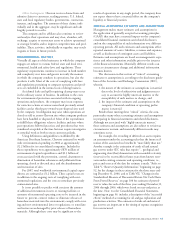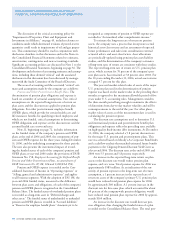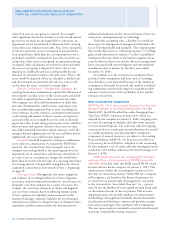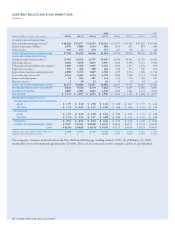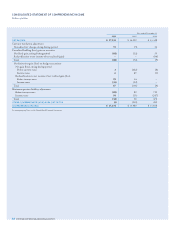Chevron 2006 Annual Report Download - page 48
Download and view the complete annual report
Please find page 48 of the 2006 Chevron annual report below. You can navigate through the pages in the report by either clicking on the pages listed below, or by using the keyword search tool below to find specific information within the annual report.
MANAGEMENT’S DISCUSSION AND ANALYSIS OF
FINANCIAL CONDITION AND RESULTS OF OPERATIONS
46 CHEVRON CORPORATION 2006 ANNUAL REPORT
value of an asset or asset group is required. For example,
when signifi cant downward revisions to crude oil and natural
gas reserves are made for any single fi eld or concession, an
impairment review is performed to determine if the carrying
value of the asset remains recoverable. Also, if the expectation
of sale of a particular asset or asset group in any period has
been deemed more likely than not, an impairment review is
performed, and if the estimated net proceeds exceed the car-
rying value of the asset or asset group, no impairment charge
is required. Such calculations are reviewed each period until
the asset or asset group is disposed of. Assets that are not
impaired on a held-and-used basis could possibly become
impaired if a decision is made to sell such assets. That is, the
assets would be impaired if they are classifi ed as held-for-sale
and the estimated proceeds from the sale, less costs to sell,
are less than the assets’ associated carrying values.
Business Combinations – Purchase-Price Allocation Ac-
counting for business combinations requires the allocation of
the company’s purchase price to the various assets and liabili-
ties of the acquired business at their respective fair values.
The company uses all available information to make these
fair value determinations, and for major acquisitions, may
hire an independent appraisal fi rm to assist in making fair
value estimates. In some instances, assumptions with respect
to the timing and amount of future revenues and expenses
associated with an asset might have to be used in determin-
ing its fair value. Actual timing and amount of net cash fl ows
from revenues and expenses related to that asset over time
may differ materially from those initial estimates, and if the
timing is delayed signifi cantly or if the net cash fl ows decline
signifi cantly, the asset could become impaired.
Goodwill Goodwill acquired in a business combination
is not subject to amortization. As required by FASB State-
ment No. 142, Goodwill and Other Intangible Assets, the
company tests such goodwill at the reporting unit level for
impairment on an annual basis and between annual tests if
an event occurs or circumstances change that would more
likely than not reduce the fair value of a reporting unit below
its carrying amount. The goodwill arising from the Unocal
acquisition is described in more detail in Note 2, beginning
on page 58.
Contingent Losses Management also makes judgments
and estimates in recording liabilities for claims, litigation,
tax matters and environmental remediation. Actual costs can
frequently vary from estimates for a variety of reasons. For
example, the costs from settlement of claims and litigation
can vary from estimates based on differing interpretations
of laws, opinions on culpability and assessments on the
amount of damages. Similarly, liabilities for environmental
remediation are subject to change because of changes in laws,
regulations and their interpretation; the determination of
additional information on the extent and nature of site con-
tamination; and improvements in technology.
Under the accounting rules, a liability is recorded for
these types of contingencies if management determines the
loss to be both probable and estimable. The company gener-
ally records these losses as “Operating expenses” or “Selling,
general and administrative expenses” on the Consolidated
Statement of Income. Refer to the business segment discus-
sions elsewhere in this section for the effect on earnings from
losses associated with certain litigation and environmental
remediation and tax matters for the three years ended
December 31, 2006.
An estimate as to the sensitivity to earnings for these
periods if other assumptions had been used in recording
these liabilities is not practicable because of the number of
contingencies that must be assessed, the number of underly-
ing assumptions and the wide range of reasonably possible
outcomes, both in terms of the probability of loss and the
estimates of such loss.
NEW ACCOUNTING STANDARDS
EITF Issue No. 04-6, Accounting for Stripping Costs Incurred
During Production in the Mining Industry (Issue 04-6) In
March 2005, the FASB ratifi ed the earlier Emerging Issues
Task Force (EITF) consensus on Issue 04-6, which was
adopted by the company on January 1, 2006. Stripping costs
are costs of removing overburden and other waste materials
to access mineral deposits. The consensus calls for stripping
costs incurred once a mine goes into production to be treated
as variable production costs that should be considered a
component of mineral inventory cost subject to Accounting
Research Bulletin (ARB) No. 43, Restatement and Revision
of Accounting Research Bulletins. Adoption of this accounting
for the company’s coal, oil sands and other mining operations
resulted in a $19 million reduction of retained earnings as of
January 1, 2006.
FASB Interpretation No. 48, Accounting for Uncertainty
in Income Taxes – An Interpretation of FASB Statement No.
109 (FIN 48) In July 2006, the FASB issued FIN 48, which
became effective for the company on January 1, 2007. This
interpretation clarifi es the accounting for income tax ben-
efi ts that are uncertain in nature. Under FIN 48, a company
will recognize a tax benefi t in the fi nancial statements for
an uncertain tax position only if management’s assessment
is that its position is “more likely than not” (i.e., a greater
than 50 percent likelihood) to be upheld on audit based only
on the technical merits of the tax position. This account-
ing interpretation also provides guidance on measurement
methodology, derecognition thresholds, fi nancial statement
classifi cation and disclosures, interest and penalties recogni-
tion, and accounting for the cumulative-effect adjustment.
The new interpretation is intended to provide better fi nancial
statement comparability among companies.



